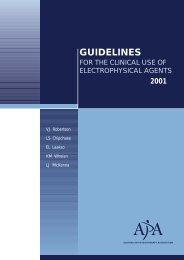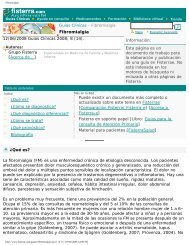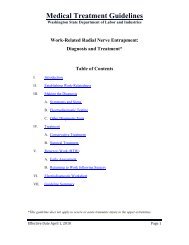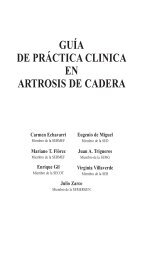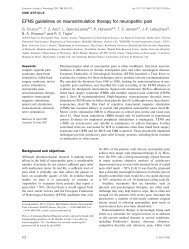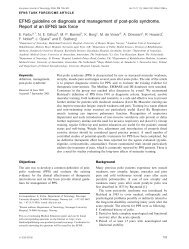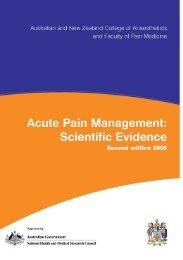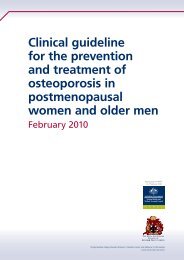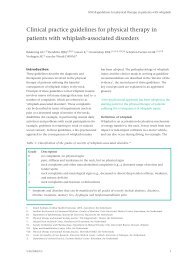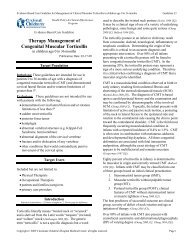Clinical Guidelines for Assessing Vertebrobasilar Insufficiency in the ...
Clinical Guidelines for Assessing Vertebrobasilar Insufficiency in the ...
Clinical Guidelines for Assessing Vertebrobasilar Insufficiency in the ...
Create successful ePaper yourself
Turn your PDF publications into a flip-book with our unique Google optimized e-Paper software.
<strong>Cl<strong>in</strong>ical</strong> <strong>Guidel<strong>in</strong>es</strong><strong>for</strong> <strong>Assess<strong>in</strong>g</strong> <strong>Vertebrobasilar</strong> <strong>Insufficiency</strong><strong>in</strong> <strong>the</strong> Management of Cervical Sp<strong>in</strong>e DisordersRevised February 2006Authors:Associate Professor Darren RivettDr Debra ShirleyDr Mary MagareyProfessor Kathryn RefshaugeThese guidel<strong>in</strong>es comprise a set of recommendations regard<strong>in</strong>g assess<strong>in</strong>g <strong>for</strong> vertebrobasilar <strong>in</strong>sufficiencyand obta<strong>in</strong><strong>in</strong>g <strong>in</strong><strong>for</strong>med consent prior to <strong>the</strong> application of cervical sp<strong>in</strong>e manipulation and mobilisation,based on <strong>the</strong> most recent evidence. These guidel<strong>in</strong>es replace <strong>the</strong> APA <strong>Cl<strong>in</strong>ical</strong> <strong>Guidel<strong>in</strong>es</strong> <strong>for</strong> Pre-Manipulative Procedures <strong>for</strong> <strong>the</strong> Cervical Sp<strong>in</strong>e (2000).The APA wishes to acknowledge Musculoskeletal Physio<strong>the</strong>rapy Australia (MPA), <strong>for</strong> <strong>the</strong> revision of <strong>the</strong>seguidel<strong>in</strong>es.© Copyright Australian Physio<strong>the</strong>rapy Association 2006This work is copyright. Apart from any use permitted under <strong>the</strong> Copyright Act 1968, no part may bereproduced by any process without prior written permission from <strong>the</strong> APA.Australian Physio<strong>the</strong>rapy AssociationPO Box 6465, St Kilda Road CentralVictoria 8008 AustraliaPhone +61 3 9534 9400Fax +61 3 9534 9199Email: national.office@physio<strong>the</strong>rapy.asn.auWebsite: www.physio<strong>the</strong>rapy.asn.auMPA IS A NATIONAL SPECIAL GROUP OF THE APA
APA <strong>Cl<strong>in</strong>ical</strong> <strong>Guidel<strong>in</strong>es</strong>IntroductionCLINICAL GUIDELINESFOR ASSESSING VERTEBROBASILAR INSUFFICIENCYIN THE MANAGEMENT OF CERVICAL SPINE DISORDERSFebruary 2006The presence or development of dizz<strong>in</strong>ess, or o<strong>the</strong>r possible symptoms of vertebrobasilar <strong>in</strong>sufficiency(VBI) should be carefully assessed <strong>in</strong> any patient <strong>for</strong> whom exam<strong>in</strong>ation or treatment of <strong>the</strong> cervical sp<strong>in</strong>e isto be undertaken. It is important that <strong>the</strong> physio<strong>the</strong>rapist has <strong>the</strong> knowledge needed to recognise symptomsand signs potentially associated with VBI. To ensure safe practice, <strong>the</strong> physio<strong>the</strong>rapist must also have athorough understand<strong>in</strong>g of <strong>the</strong> implications of such symptoms and signs <strong>in</strong> <strong>the</strong> management of cervicalsp<strong>in</strong>e disorders. The aim of <strong>the</strong>se cl<strong>in</strong>ical guidel<strong>in</strong>es is to facilitate <strong>the</strong> cl<strong>in</strong>ical recognition of VBI by allphysio<strong>the</strong>rapists who treat <strong>the</strong> cervical sp<strong>in</strong>e us<strong>in</strong>g procedures which could compromise <strong>the</strong> vertebral arteryor trigger adverse neurovascular events, most notably cervical manipulation and mobilisation 16, 17 . For <strong>the</strong>purpose of <strong>the</strong>se cl<strong>in</strong>ical guidel<strong>in</strong>es, manipulation is def<strong>in</strong>ed as a procedure <strong>in</strong>volv<strong>in</strong>g a high velocity thrust,whereas <strong>the</strong> term mobilisation refers to any o<strong>the</strong>r manual jo<strong>in</strong>t movement procedure applied to <strong>the</strong> cervicalsp<strong>in</strong>e.This document details <strong>the</strong> symptoms and signs that may be potentially associated with VBI, toge<strong>the</strong>r withcl<strong>in</strong>ical guidel<strong>in</strong>es recommended by <strong>the</strong> Australian Physio<strong>the</strong>rapy Association (APA) and MusculoskeletalPhysio<strong>the</strong>rapy Australia (MPA, a National Special Group of <strong>the</strong> APA) <strong>for</strong> exam<strong>in</strong>ation and treatment of allpatients with disorders of <strong>the</strong> cervical sp<strong>in</strong>e. While <strong>the</strong> cl<strong>in</strong>ical guidel<strong>in</strong>es are recommended, <strong>the</strong>y areprimarily provided to help <strong>in</strong><strong>for</strong>m <strong>the</strong> cl<strong>in</strong>ical reason<strong>in</strong>g of <strong>the</strong> physio<strong>the</strong>rapist <strong>in</strong> <strong>the</strong>ir management of <strong>the</strong><strong>in</strong>dividual patient. The document also describes <strong>the</strong> recommended procedure <strong>for</strong> provision of <strong>in</strong><strong>for</strong>mation topatients about cervical manipulation and mobilisation, obta<strong>in</strong><strong>in</strong>g consent and <strong>the</strong> record<strong>in</strong>g of <strong>the</strong>se steps.The physio<strong>the</strong>rapist is rem<strong>in</strong>ded that VBI is not <strong>the</strong> only safety consideration when assess<strong>in</strong>g and treat<strong>in</strong>g<strong>the</strong> cervical sp<strong>in</strong>e, and to this end a checklist <strong>for</strong> use prior to sp<strong>in</strong>al manipulation 21 is <strong>in</strong>cluded <strong>for</strong> <strong>in</strong><strong>for</strong>mation<strong>in</strong> Appendix 1. A summative <strong>Cl<strong>in</strong>ical</strong> Flowchart <strong>for</strong> <strong>the</strong> appropriate application of cervical manipulation andmobilisation procedures <strong>in</strong>volv<strong>in</strong>g end-range rotation is <strong>in</strong>cluded <strong>in</strong> Appendix 2. Key support<strong>in</strong>g referencesare found <strong>in</strong> Appendix 3.Physio<strong>the</strong>rapists should be aware of <strong>the</strong> follow<strong>in</strong>g po<strong>in</strong>ts <strong>in</strong> relation to <strong>the</strong> use of provocative test<strong>in</strong>g <strong>for</strong> VBI:• The tests <strong>the</strong>mselves are provocative and <strong>the</strong>re<strong>for</strong>e hold some <strong>in</strong>herent risk. However, if appropriatelyselected and per<strong>for</strong>med with care (<strong>in</strong>clud<strong>in</strong>g only to <strong>the</strong> <strong>in</strong>itial po<strong>in</strong>t of provocation of symptoms), anypotential risk to <strong>the</strong> patient will be m<strong>in</strong>imised. The provocation of symptoms or signs dur<strong>in</strong>g test<strong>in</strong>gshould alert <strong>the</strong> physio<strong>the</strong>rapist to <strong>the</strong> need <strong>for</strong> particular care <strong>in</strong> <strong>the</strong> selection of exam<strong>in</strong>ation andtreatment procedures.• The recommended tests are <strong>the</strong> most valid procedures <strong>for</strong> determ<strong>in</strong><strong>in</strong>g <strong>the</strong> presence of VBI and <strong>the</strong>adequacy of <strong>the</strong> collateral circulation identified <strong>in</strong> <strong>the</strong> literature to date 3, 6 . Although <strong>the</strong> tests have shownmixed results <strong>in</strong> relation to changes <strong>in</strong> vertebrobasilar arterial blood flow <strong>in</strong> experimental studies24, 33 1, 4, 9, 12, 13, 14, 15, 18, 19, 20, 24, 25,, it appears that end-range rotation is <strong>the</strong> most sensitive cervical position28, 31 . Recent research has also identified blood flow changes <strong>in</strong> <strong>the</strong> simulated manipulation position 1 .• There is no simple cl<strong>in</strong>ical method <strong>for</strong> test<strong>in</strong>g <strong>the</strong> <strong>in</strong>tr<strong>in</strong>sic state of <strong>the</strong> vertebral artery andphysio<strong>the</strong>rapists should be cognisant of this when exam<strong>in</strong><strong>in</strong>g or treat<strong>in</strong>g <strong>the</strong> cervical sp<strong>in</strong>e. Therecommended tests will not identify all patients at risk of suffer<strong>in</strong>g an adverse event follow<strong>in</strong>g cervicalmanipulation or mobilisation.Assessment <strong>for</strong> <strong>the</strong> presence of symptoms and signs associated with VBI occurs at four stages <strong>in</strong> <strong>the</strong>management of a patient with an upper quadrant disorder:1. History (subjective exam<strong>in</strong>ation)2. Physical (objective) exam<strong>in</strong>ation3. Dur<strong>in</strong>g treatment of <strong>the</strong> cervical sp<strong>in</strong>e, and4. Follow<strong>in</strong>g treatment.10, 15, 20, 23,Decisions on management, <strong>in</strong>clud<strong>in</strong>g choice of treatment, should be cont<strong>in</strong>ually (re-)evaluated on <strong>the</strong> basisof <strong>the</strong> outcome of <strong>the</strong>se assessments.APA <strong>Cl<strong>in</strong>ical</strong> <strong>Guidel<strong>in</strong>es</strong> ©APA 2006 Page 2 of 14<strong>for</strong> <strong>Assess<strong>in</strong>g</strong> <strong>Vertebrobasilar</strong> <strong>Insufficiency</strong><strong>in</strong> <strong>the</strong> Management of Cervical Sp<strong>in</strong>e Disorders
APA <strong>Cl<strong>in</strong>ical</strong> <strong>Guidel<strong>in</strong>es</strong>Section 1. History (Subjective Exam<strong>in</strong>ation)In every patient present<strong>in</strong>g with upper quadrant dysfunction, question<strong>in</strong>g is specifically directed todeterm<strong>in</strong>e <strong>the</strong> presence of dizz<strong>in</strong>ess which is <strong>the</strong> most common present<strong>in</strong>g symptom of VBI. If dizz<strong>in</strong>ess ispresent, o<strong>the</strong>r symptoms associated with VBI should be sought, <strong>in</strong>clud<strong>in</strong>g:• Visual disturbances such as diplopia (double vision), blurred vision and transient hemianopia• Dysarthria (difficulty with speech)• Dysphagia (difficulty with swallow<strong>in</strong>g)• Drop attacks (sudden loss of power with no loss of consciousness)• Nausea and vomit<strong>in</strong>g• Ligh<strong>the</strong>adedness and fa<strong>in</strong>t<strong>in</strong>g• Disorientation or anxiety• Hear<strong>in</strong>g disturbances such as t<strong>in</strong>nitus• Facial or oral paraes<strong>the</strong>sia or anaes<strong>the</strong>sia• Pallor, tremors and sweat<strong>in</strong>g• O<strong>the</strong>r neurological symptoms.Enquiry should also determ<strong>in</strong>e <strong>the</strong> nature of any neck pa<strong>in</strong> or headache, which are usually <strong>the</strong> firstsymptoms of dissection of <strong>the</strong> vertebral artery. Specifically, sudden, severe, sharp pa<strong>in</strong> located <strong>in</strong> <strong>the</strong>ipsilateral postero-superior region of <strong>the</strong> neck and occiput and <strong>for</strong> which <strong>the</strong>re is no past history should beregarded as suspicious 8, 11 . Patients may also report a history of cervical trauma 7 or neck stiffness, and <strong>the</strong>irneck range of motion can be restricted. Pa<strong>in</strong> usually precedes ischaemic symptoms and signs, with <strong>the</strong> time<strong>in</strong>terval vary<strong>in</strong>g among <strong>in</strong>dividuals 29 . Until <strong>the</strong> ischaemic response becomes manifest it can be difficult todifferentiate a dissect<strong>in</strong>g vertebral artery from a benign mechanical neck disorder. It is <strong>the</strong>re<strong>for</strong>e prudent to<strong>in</strong>itially treat conservatively and carefully monitor progress.Should <strong>the</strong> patient suffer from any of <strong>the</strong> symptoms associated with VBI described above, <strong>the</strong>n question<strong>in</strong>gshould explore <strong>the</strong> symptoms fur<strong>the</strong>r, <strong>in</strong>clud<strong>in</strong>g:• The type, degree, frequency and duration of <strong>the</strong> dizz<strong>in</strong>ess or o<strong>the</strong>r symptoms• The production or aggravation of <strong>the</strong> symptoms by neck movements or susta<strong>in</strong>ed positions, particularlythose <strong>in</strong>volv<strong>in</strong>g rotation or extension• The temporal history of <strong>the</strong> symptoms relative to <strong>the</strong> history of <strong>the</strong> patient’s compla<strong>in</strong>t• The status of <strong>the</strong> symptoms• Any previous treatment and its effect on <strong>the</strong> symptoms.Some features may facilitate differentiation of dizz<strong>in</strong>ess or o<strong>the</strong>r symptoms associated with VBI from similar2, 5, 32symptoms produced by o<strong>the</strong>r conditions:• Constancy of symptoms– symptoms associated with VBI are rarely constant• Provocation of symptoms– by a change of position <strong>in</strong> relation to gravity is strongly <strong>in</strong>dicative of a vestibular disorder or, if from alow to a high position, orthostatic hypotension– by roll<strong>in</strong>g <strong>in</strong> bed ra<strong>the</strong>r than by head movement is typical of a vestibular disorder, particularly ifaccompanied by nystagmus• Symptoms and nystagmus that are latent, fatiguable and habituate are typical of a vestibular disorder.When nystagmus is associated with VBI, it demonstrates no fatiguability.It should be noted, however, that o<strong>the</strong>r conditions such as vestibular disease, ear disease, cardiovasculardisease, migra<strong>in</strong>e, epilepsy, stroke and head <strong>in</strong>jury may co-exist with VBI 2, 5, 32 .APA <strong>Cl<strong>in</strong>ical</strong> <strong>Guidel<strong>in</strong>es</strong> ©APA 2006 Page 3 of 14<strong>for</strong> <strong>Assess<strong>in</strong>g</strong> <strong>Vertebrobasilar</strong> <strong>Insufficiency</strong><strong>in</strong> <strong>the</strong> Management of Cervical Sp<strong>in</strong>e Disorders
APA <strong>Cl<strong>in</strong>ical</strong> <strong>Guidel<strong>in</strong>es</strong>Section 2. Physical (Objective) Exam<strong>in</strong>ation2.1 Rout<strong>in</strong>e exam<strong>in</strong>ation <strong>for</strong> all patients with upper quadrant dysfunctionIn every patient <strong>for</strong> whom treatment of <strong>the</strong> cervical sp<strong>in</strong>e is to be per<strong>for</strong>med, rout<strong>in</strong>e physical exam<strong>in</strong>ation of<strong>the</strong> cervical sp<strong>in</strong>e must be undertaken, <strong>in</strong>clud<strong>in</strong>g physiological movements to <strong>the</strong> end of available range withoverpressure (where applicable). Physio<strong>the</strong>rapists should enquire about <strong>the</strong> presence of any symptomsassociated with VBI and observe <strong>for</strong> any signs regularly throughout <strong>the</strong> physical (objective) exam<strong>in</strong>ation,most notably dur<strong>in</strong>g cervical physiological and accessory movement test<strong>in</strong>g. In patients whose physiologicalmovements are restricted by pa<strong>in</strong> or stiffness, <strong>the</strong> vertebrobasilar system may not be adequatelycompromised. Physio<strong>the</strong>rapists should be m<strong>in</strong>dful of this limitation to <strong>the</strong>ir exam<strong>in</strong>ation and consider this<strong>in</strong><strong>for</strong>mation <strong>in</strong> <strong>the</strong>ir decision-mak<strong>in</strong>g about treatment choice.2.2 Test<strong>in</strong>g <strong>for</strong> patients who report symptoms associated with VBI dur<strong>in</strong>g <strong>the</strong>history (subjective exam<strong>in</strong>ation)If reported symptoms are clearly <strong>in</strong>dicative of VBI or vertebral artery dissection <strong>the</strong>n provocative test<strong>in</strong>g is notrequired and medical op<strong>in</strong>ion should be sought prior to undertak<strong>in</strong>g any exam<strong>in</strong>ation or treatment of <strong>the</strong>cervical sp<strong>in</strong>e. In such cases, <strong>the</strong> physio<strong>the</strong>rapist should be m<strong>in</strong>dful that <strong>the</strong> tests by <strong>the</strong>ir very nature can bestressful to <strong>the</strong> vertebral artery. When symptoms are undifferentiated or unclear as to <strong>the</strong>ir orig<strong>in</strong>, provocativetest<strong>in</strong>g should be undertaken <strong>in</strong> sup<strong>in</strong>e ly<strong>in</strong>g or sitt<strong>in</strong>g as <strong>in</strong>dicated by <strong>the</strong> patient’s history (subjectiveexam<strong>in</strong>ation) 25, 33 .If dizz<strong>in</strong>ess or o<strong>the</strong>r symptoms are provoked <strong>in</strong> ei<strong>the</strong>r of <strong>the</strong>se positions (i.e. sup<strong>in</strong>e ly<strong>in</strong>g or sitt<strong>in</strong>g), <strong>the</strong> testcan be repeated <strong>in</strong> <strong>the</strong> alternative position. This will facilitate differentiation between symptoms caused byVBI and those related to <strong>the</strong> vestibular system. This is because <strong>the</strong> vestibular system is affected by gravityso that symptoms will be different <strong>in</strong> sup<strong>in</strong>e ly<strong>in</strong>g compared to sitt<strong>in</strong>g, whereas symptoms related to VBI willbe essentially unchanged 32 .The recommended m<strong>in</strong>imum test<strong>in</strong>g <strong>for</strong> a patient who reports symptoms associated with VBI (but which arenot clearly <strong>in</strong>dicative of neurological ischaemia) comprises <strong>the</strong> follow<strong>in</strong>g:• Any position or movement which provokes symptoms as described by <strong>the</strong> patient• Susta<strong>in</strong>ed end-range cervical rotation to <strong>the</strong> left and right if any cervical procedure is be<strong>in</strong>g consideredwhich is equal or greater <strong>in</strong> vigour to this test 25 .‣ All positions should be susta<strong>in</strong>ed <strong>for</strong> a m<strong>in</strong>imum of 10 seconds, unless symptoms or signs are provokedsooner. The physio<strong>the</strong>rapist should exam<strong>in</strong>e <strong>the</strong> patient’s eyes <strong>for</strong> <strong>the</strong> production of nystagmus while<strong>the</strong> neck is held <strong>in</strong> <strong>the</strong> susta<strong>in</strong>ed position and simultaneously question <strong>the</strong> patient about <strong>the</strong>(re)production of symptoms.‣ On return to neutral from <strong>the</strong> susta<strong>in</strong>ed position, a period of at least 10 seconds should be allowedbe<strong>for</strong>e proceed<strong>in</strong>g with <strong>the</strong> next exam<strong>in</strong>ation procedure. Dur<strong>in</strong>g this time, <strong>the</strong> patient should bequestioned about <strong>the</strong> provocation of symptoms and <strong>the</strong> patient's eyes should aga<strong>in</strong> be observed <strong>for</strong>nystagmus. Physio<strong>the</strong>rapists should be aware of <strong>the</strong> potential <strong>for</strong> a latent response to movement andpositional test<strong>in</strong>g.‣ Provocative test<strong>in</strong>g should be immediately ceased upon provocation of symptoms or signs clearly<strong>in</strong>dicative of VBI.The physio<strong>the</strong>rapist must determ<strong>in</strong>e <strong>the</strong> benefit of additional test<strong>in</strong>g <strong>for</strong> any particular patient based on <strong>the</strong>ircl<strong>in</strong>ical presentation. If additional test<strong>in</strong>g is required to fur<strong>the</strong>r test <strong>for</strong> <strong>the</strong> presence of symptoms or signsassociated with VBI or fur<strong>the</strong>r test collateral circulation, upper cervical extension can be added to end-rangerotation and susta<strong>in</strong>ed as described above.If dizz<strong>in</strong>ess is provoked upon rotation movement or susta<strong>in</strong>ed position and its orig<strong>in</strong> is unclear, rotation canbe fur<strong>the</strong>r explored <strong>in</strong> <strong>the</strong> stand<strong>in</strong>g position <strong>in</strong> order to differentiate dizz<strong>in</strong>ess aris<strong>in</strong>g from <strong>the</strong> vestibularapparatus of <strong>the</strong> <strong>in</strong>ner ear from that aris<strong>in</strong>g from <strong>the</strong> cervical sp<strong>in</strong>e (ei<strong>the</strong>r cervical vertigo or VBI):• For positional provocation, head held still by <strong>the</strong> physio<strong>the</strong>rapist with susta<strong>in</strong>ed trunk rotation to left andright.• For movement provocation, head held still by <strong>the</strong> physio<strong>the</strong>rapist with active trunk rotation to left andright.Aga<strong>in</strong>, susta<strong>in</strong>ed positions are held <strong>for</strong> a m<strong>in</strong>imum of 10 seconds, or less if symptoms or signs are provoked.Provocation of dizz<strong>in</strong>ess dur<strong>in</strong>g differentiation test<strong>in</strong>g suggests that it is not caused by a vestibular disorder.APA <strong>Cl<strong>in</strong>ical</strong> <strong>Guidel<strong>in</strong>es</strong> ©APA 2006 Page 4 of 14<strong>for</strong> <strong>Assess<strong>in</strong>g</strong> <strong>Vertebrobasilar</strong> <strong>Insufficiency</strong><strong>in</strong> <strong>the</strong> Management of Cervical Sp<strong>in</strong>e Disorders
APA <strong>Cl<strong>in</strong>ical</strong> <strong>Guidel<strong>in</strong>es</strong>2.3 Test<strong>in</strong>g prior to manipulation or any treatment procedure <strong>in</strong>volv<strong>in</strong>g end-rangerotationIf cervical manipulation or any cervical treatment procedure <strong>in</strong>volv<strong>in</strong>g end-range rotation is be<strong>in</strong>g considered,test<strong>in</strong>g as outl<strong>in</strong>ed <strong>in</strong> Section 2.2 is recommended. The simulated manipulation position (pre-manipulativehold) is also recommended if manipulation is <strong>the</strong> proposed treatment 1 . Because a patient’s vascular statusmay change between treatment sessions, test<strong>in</strong>g should be undertaken on every occasion a cervicalmanipulation or any procedure <strong>in</strong>volv<strong>in</strong>g end-range rotation is to be per<strong>for</strong>med <strong>in</strong> an attempt to detect <strong>the</strong>patient <strong>for</strong> whom such treatments would be <strong>in</strong>appropriate as a result of provocation of symptoms or signs<strong>in</strong>dicative of VBI.Interpretation of f<strong>in</strong>d<strong>in</strong>gsIt is recommended that:‣ If <strong>the</strong>re is evidence at any time that symptoms or signs are clearly associated with VBI, cervicalmanipulation and mobilisation should not be undertaken and referral to a medical practitioner <strong>in</strong>itiated.‣ If <strong>the</strong>re is evidence of unclear symptoms or signs potentially associated with VBI from ei<strong>the</strong>r <strong>the</strong> history(subjective exam<strong>in</strong>ation) or physical (objective) exam<strong>in</strong>ation, cervical manipulation and any procedures<strong>in</strong>volv<strong>in</strong>g end-range rotation should not be undertaken, although o<strong>the</strong>r mobilisation procedures maybe applied provided <strong>the</strong> patient is carefully monitored. Because provocative test<strong>in</strong>g is limited <strong>in</strong> itspredictive validity <strong>for</strong> adverse neurovascular events 26, 30 , a report of symptoms potentially associatedwith VBI <strong>in</strong> <strong>the</strong> history (subjective exam<strong>in</strong>ation) should be given greater weight <strong>in</strong> cl<strong>in</strong>ical decisionmak<strong>in</strong>gthan a negative test response.‣ The physio<strong>the</strong>rapist should exercise sound cl<strong>in</strong>ical reason<strong>in</strong>g <strong>in</strong> apply<strong>in</strong>g <strong>the</strong>se guidel<strong>in</strong>es to <strong>in</strong>dividualpatients and be aware that responses to provocative test<strong>in</strong>g per<strong>for</strong>med at subsequent treatmentsessions may change.‣ If an adverse neurovascular event occurs despite apply<strong>in</strong>g <strong>the</strong>se guidel<strong>in</strong>es <strong>the</strong>n treatment should beimmediately ceased, first aid practices implemented and emergency assistance sought.Section 3Assessment Dur<strong>in</strong>g and Follow<strong>in</strong>g TreatmentDur<strong>in</strong>g and follow<strong>in</strong>g adm<strong>in</strong>istration of any cervical manipulative procedure or any cervical treatmentprocedure <strong>in</strong>volv<strong>in</strong>g end-range rotation, <strong>the</strong> physio<strong>the</strong>rapist must determ<strong>in</strong>e <strong>the</strong> presence or absence ofsymptoms and signs associated with VBI. Specific question<strong>in</strong>g about symptoms and observation <strong>for</strong> signsassociated with VBI is essential at <strong>the</strong> follow<strong>in</strong>g po<strong>in</strong>ts dur<strong>in</strong>g management:• Immediately prior and subsequent to a cervical manipulative procedure, <strong>in</strong>clud<strong>in</strong>g assessment <strong>for</strong> alatent response.• Dur<strong>in</strong>g and immediately subsequent to any cervical treatment procedure <strong>in</strong>volv<strong>in</strong>g end-range rotation,<strong>in</strong>clud<strong>in</strong>g assessment <strong>for</strong> a latent response.• Dur<strong>in</strong>g and immediately subsequent to any treatment of a patient who has reported symptomsassociated with VBI <strong>in</strong> <strong>the</strong> history (subjective exam<strong>in</strong>ation) or when such symptoms (or signs) areprovoked dur<strong>in</strong>g <strong>the</strong> physical exam<strong>in</strong>ation, <strong>in</strong>clud<strong>in</strong>g assessment <strong>for</strong> a latent response.• At subsequent visits enquiry should be made as to whe<strong>the</strong>r any symptoms or signs associated with VBI,or neck pa<strong>in</strong> or headache suggestive of vertebral artery dissection has been experienced.If symptoms or signs associated with VBI are provoked dur<strong>in</strong>g or follow<strong>in</strong>g treatment, <strong>the</strong> physical (objective)exam<strong>in</strong>ation guidel<strong>in</strong>es outl<strong>in</strong>ed <strong>in</strong> Sections 2.2 and 2.3 above should be applied prior to cont<strong>in</strong>uation withtreatment.If cervical manipulation is <strong>in</strong>dicated, <strong>the</strong> risks associated with this procedure may be m<strong>in</strong>imised by avoid<strong>in</strong>g<strong>the</strong> follow<strong>in</strong>g practices: 22• Non-specific multisegmental procedures.• Procedures <strong>in</strong>volv<strong>in</strong>g upper cervical sp<strong>in</strong>e rotation, end-range cervical sp<strong>in</strong>e rotation or extension, orneck traction.• Use of excessive thrust<strong>in</strong>g <strong>for</strong>ce or range of movement.• Multiple manipulations of <strong>the</strong> same or different cervical jo<strong>in</strong>ts <strong>in</strong> any one treatment session.It is recommended that cervical mobilisation be used <strong>in</strong>itially with its effects assessed over at least 24 hoursprior to <strong>the</strong> application of cervical manipulation.APA <strong>Cl<strong>in</strong>ical</strong> <strong>Guidel<strong>in</strong>es</strong> ©APA 2006 Page 5 of 14<strong>for</strong> <strong>Assess<strong>in</strong>g</strong> <strong>Vertebrobasilar</strong> <strong>Insufficiency</strong><strong>in</strong> <strong>the</strong> Management of Cervical Sp<strong>in</strong>e Disorders
APA <strong>Cl<strong>in</strong>ical</strong> <strong>Guidel<strong>in</strong>es</strong>Section 4Consent: Provision of In<strong>for</strong>mation, Obta<strong>in</strong><strong>in</strong>g Consent and Record<strong>in</strong>g4.1 Provision of <strong>in</strong><strong>for</strong>mation• It is essential that physio<strong>the</strong>rapists provide patients with <strong>in</strong><strong>for</strong>mation about proposed treatmentprocedures, <strong>in</strong> particular cervical manipulation or any cervical procedure <strong>in</strong>volv<strong>in</strong>g end-range rotation.• In<strong>for</strong>mation may be provided verbally by <strong>the</strong> physio<strong>the</strong>rapist, or preferably <strong>in</strong> an <strong>in</strong><strong>for</strong>mationsheet/brochure to ensure that <strong>the</strong> <strong>in</strong><strong>for</strong>mation is standardised. Such <strong>in</strong><strong>for</strong>mation, whe<strong>the</strong>r deliveredverbally or <strong>in</strong> writ<strong>in</strong>g, must cover <strong>the</strong> follow<strong>in</strong>g:– <strong>in</strong><strong>for</strong>mation about <strong>the</strong> proposed procedure– alternatives to <strong>the</strong> proposed procedure– benefits and risks of <strong>the</strong> proposed procedure and alternatives– <strong>the</strong> opportunity to ask questions– <strong>the</strong> opportunity to have adequate time to reflect on <strong>the</strong> <strong>in</strong><strong>for</strong>mation provided be<strong>for</strong>e agree<strong>in</strong>g to <strong>the</strong>proposed procedure– <strong>the</strong> opportunity <strong>for</strong> <strong>the</strong> patient to change <strong>the</strong>ir m<strong>in</strong>d dur<strong>in</strong>g <strong>the</strong> procedure (where practical).• Provision of an <strong>in</strong><strong>for</strong>mation sheet/brochure is optional but allows <strong>the</strong> patient <strong>the</strong> opportunity to read about<strong>the</strong> proposed procedure at <strong>the</strong>ir own pace and <strong>for</strong>mulate any questions. It can be given to <strong>the</strong> patient toread <strong>in</strong> <strong>the</strong> wait<strong>in</strong>g room or cl<strong>in</strong>ic prior to treatment or to take home if <strong>the</strong> patient needs fur<strong>the</strong>r time todecide whe<strong>the</strong>r to proceed.• The physio<strong>the</strong>rapist must be prepared to verbally provide <strong>in</strong><strong>for</strong>mation beyond what is written <strong>in</strong> <strong>the</strong><strong>in</strong><strong>for</strong>mation sheet/brochure if <strong>the</strong> patient requests fur<strong>the</strong>r <strong>in</strong><strong>for</strong>mation, or if <strong>the</strong>re is fur<strong>the</strong>r <strong>in</strong><strong>for</strong>mation that<strong>the</strong> patient would likely consider important.• In<strong>for</strong>mation provided about cervical manipulation should <strong>in</strong>clude <strong>the</strong> remote risks of stroke and death.Whilst <strong>the</strong> risk of death from cervical manipulation, as identified from review of <strong>the</strong> literature, appears tobe less than that encountered <strong>in</strong> daily life, it is considered legally pert<strong>in</strong>ent to mention <strong>the</strong> risk. Giventhis legal op<strong>in</strong>ion <strong>the</strong> APA recommends that <strong>the</strong> <strong>in</strong><strong>for</strong>mation provided to <strong>the</strong> patient of <strong>the</strong> risks<strong>in</strong>herent <strong>in</strong> <strong>the</strong> procedure should <strong>in</strong>clude specific mention of <strong>the</strong> risk of death.• The physio<strong>the</strong>rapist has a responsibility to ensure that <strong>the</strong> patient understands <strong>the</strong> <strong>in</strong><strong>for</strong>mation provided.MPA has produced an <strong>in</strong><strong>for</strong>mation brochure entitled ‘Patient In<strong>for</strong>mation, Neck Mobilisation andManipulation: The Facts Expla<strong>in</strong>ed’ on <strong>the</strong> risks and benefits associated with cervical manipulation andmobilisation <strong>in</strong> which <strong>the</strong> above issues are essentially covered. Use of this brochure is recommended as anappropriate method of provid<strong>in</strong>g <strong>in</strong><strong>for</strong>mation to patients about cervical manipulation and mobilisation. Thebrochure is available from <strong>the</strong> APA website www.physio<strong>the</strong>rapy.asn.au or <strong>in</strong> hardcopy from MPA.4.2 Obta<strong>in</strong><strong>in</strong>g <strong>in</strong><strong>for</strong>med consentIn<strong>for</strong>med consent is def<strong>in</strong>ed as '<strong>the</strong> voluntary and revocable agreement of a competent <strong>in</strong>dividual toparticipate <strong>in</strong> a <strong>the</strong>rapeutic or research procedure, based on an adequate understand<strong>in</strong>g of its nature,purpose, and implications' 27 . In<strong>for</strong>med consent where a patient explicitly <strong>in</strong>dicates agreement (ei<strong>the</strong>r verballyor <strong>in</strong> writ<strong>in</strong>g) follow<strong>in</strong>g adequate provision of <strong>in</strong><strong>for</strong>mation about <strong>the</strong> proposed procedure (see Section 4.1)must be obta<strong>in</strong>ed:• For cervical manipulation on each occasion a manipulative procedure is per<strong>for</strong>med, even if <strong>the</strong> sameprocedure is repeated.• For any cervical treatment procedure that <strong>in</strong>volves end-range rotation on each occasion such aprocedure is per<strong>for</strong>med, even if <strong>the</strong> same procedure is repeated.The physio<strong>the</strong>rapist may only ask <strong>for</strong> consent to proceed follow<strong>in</strong>g <strong>the</strong> provision of <strong>in</strong><strong>for</strong>mation as outl<strong>in</strong>ed <strong>in</strong>Section 4.1 above. Consent is only valid if it is given freely and with an adequate understand<strong>in</strong>g of what <strong>the</strong>procedure entails.APA <strong>Cl<strong>in</strong>ical</strong> <strong>Guidel<strong>in</strong>es</strong> ©APA 2006 Page 6 of 14<strong>for</strong> <strong>Assess<strong>in</strong>g</strong> <strong>Vertebrobasilar</strong> <strong>Insufficiency</strong><strong>in</strong> <strong>the</strong> Management of Cervical Sp<strong>in</strong>e Disorders
APA <strong>Cl<strong>in</strong>ical</strong> <strong>Guidel<strong>in</strong>es</strong>4.3 Record<strong>in</strong>g <strong>in</strong><strong>for</strong>med consent• Provision of <strong>in</strong><strong>for</strong>mation and obta<strong>in</strong><strong>in</strong>g of consent must be recorded <strong>in</strong> a standardised manner <strong>in</strong> <strong>the</strong>patient’s cl<strong>in</strong>ical notes at each treatment of cervical manipulation or any procedure <strong>in</strong>volv<strong>in</strong>g end-rangerotation. A stamp or sticker with <strong>the</strong> follow<strong>in</strong>g <strong>in</strong><strong>for</strong>mation (available from <strong>the</strong> APA atwww.physio<strong>the</strong>rapy.asn.au) is recommended to facilitate such record<strong>in</strong>g:RECORD OF INFORMED CONSENTProposed treatment procedure: _______________________________________________________________________________Method(s) used to provide <strong>in</strong><strong>for</strong>mation: Verbal WrittenDiscussion of treatment covered: What <strong>the</strong> treatment <strong>in</strong>volves Potential benefits and risks of <strong>the</strong> proposed treatment Alternatives to <strong>the</strong> proposed treatment Opportunity <strong>for</strong> patient to ask questions Questions asked and answered Opportunity <strong>for</strong> patient to select alternative treatmentSigned (Physio<strong>the</strong>rapist): ________________________________Date: _______________________________ Time: ___________I confirm that:•I have been adequately <strong>in</strong><strong>for</strong>med about <strong>the</strong> proposed treatment.•I have understood <strong>the</strong> <strong>in</strong><strong>for</strong>mation provided.•I consent to <strong>the</strong> proposed treatment.Signed (Patient): _______________________________________Date: _______________________________ Time: ___________• Each bullet po<strong>in</strong>t should be <strong>in</strong>itialled by <strong>the</strong> physio<strong>the</strong>rapist, with care taken to record <strong>the</strong> date and timeat which consent was given. This is particularly important if <strong>the</strong> physio<strong>the</strong>rapist needs to seek consent<strong>for</strong> more than one procedure <strong>in</strong> <strong>the</strong> one treatment session. It is essential that consent <strong>for</strong> eachprocedure is recorded separately.• Whilst it is not legally necessary to obta<strong>in</strong> written consent from <strong>the</strong> patient <strong>for</strong> any cervicalprocedure, <strong>in</strong>clud<strong>in</strong>g manipulation, <strong>the</strong> APA recommends that <strong>the</strong> physio<strong>the</strong>rapist obta<strong>in</strong>ssigned consent prior to manipulation.• It is also worth not<strong>in</strong>g that some professional <strong>in</strong>demnity <strong>in</strong>surance policies require that signed consentbe obta<strong>in</strong>ed prior to manipulation.Disclaimer:These cl<strong>in</strong>ical guidel<strong>in</strong>es have been prepared hav<strong>in</strong>g regard to general circumstances, and it is <strong>the</strong>responsibility of <strong>the</strong> practitioner to have express regard to <strong>the</strong> particular circumstances of each case, and<strong>the</strong> application of <strong>the</strong>se guidel<strong>in</strong>es <strong>in</strong> each case. In particular, cl<strong>in</strong>ical management must always beresponsive to <strong>the</strong> needs of <strong>in</strong>dividual patients, resources and limitations unique to <strong>the</strong> <strong>in</strong>stitutions or type ofpractice. These cl<strong>in</strong>ical guidel<strong>in</strong>es have been prepared hav<strong>in</strong>g regard to <strong>the</strong> <strong>in</strong><strong>for</strong>mation available at <strong>the</strong>time of <strong>the</strong>ir preparation, and <strong>the</strong> practitioner should <strong>the</strong>re<strong>for</strong>e have regard to any <strong>in</strong><strong>for</strong>mation, research ormaterial which may have been published or become available subsequently. While <strong>the</strong> APA endeavours toensure that cl<strong>in</strong>ical guidel<strong>in</strong>es are as current as possible at <strong>the</strong> time of <strong>the</strong>ir preparation, it takes noresponsibility <strong>for</strong> matters aris<strong>in</strong>g from changed circumstances or <strong>in</strong><strong>for</strong>mation or material which may havebecome available subsequently.APA <strong>Cl<strong>in</strong>ical</strong> <strong>Guidel<strong>in</strong>es</strong> ©APA 2006 Page 7 of 14<strong>for</strong> <strong>Assess<strong>in</strong>g</strong> <strong>Vertebrobasilar</strong> <strong>Insufficiency</strong><strong>in</strong> <strong>the</strong> Management of Cervical Sp<strong>in</strong>e Disorders
APA <strong>Cl<strong>in</strong>ical</strong> <strong>Guidel<strong>in</strong>es</strong>Appendix 1Checklist <strong>for</strong> Use Prior to Sp<strong>in</strong>al ManipulationReproduced from: Refshauge,K.M., Parry,S., Shirley,D., Larsen,D., Rivett,D.A. and Boland, R. Professionalresponsibility <strong>in</strong> relation to cervical sp<strong>in</strong>e manipulation. Australian Journal of Physio<strong>the</strong>rapy 48: 171-179(2002).PATIENT’S NAME:.....................................................DATE:.........................................................................Manipulation is not usually considered an appropriate treatment <strong>for</strong> elderly patients, teenagers or children.Screen<strong>in</strong>g consists of clearance by <strong>the</strong> treat<strong>in</strong>g physio<strong>the</strong>rapist by complet<strong>in</strong>g <strong>the</strong> follow<strong>in</strong>g checklist, <strong>in</strong>addition to ensur<strong>in</strong>g that:a) APA <strong>Cl<strong>in</strong>ical</strong> <strong>Guidel<strong>in</strong>es</strong> <strong>for</strong> <strong>Assess<strong>in</strong>g</strong> <strong>Vertebrobasilar</strong> <strong>Insufficiency</strong> <strong>in</strong> <strong>the</strong> Management of Cervical Sp<strong>in</strong>eDisorders are followed prior to manipulationb) Consent is ga<strong>in</strong>edc) <strong>Vertebrobasilar</strong> <strong>in</strong>sufficiency questionnaire is completed (cervical region only).GENERALCHECKLIST FOR CONTRA-INDICATIONS (AND PRECAUTIONS) TO MANIPULATION1. Presence of signs/symptoms that <strong>in</strong>dicate serious pathology, ie:• is pa<strong>in</strong> constant? yes no • is pa<strong>in</strong> related to movement? yes no • presence of severe spasm yes no • presence of morn<strong>in</strong>g stiffness (> half hour) yes no • presence of severe night pa<strong>in</strong> yes no • presence of night sweats yes no • history of cancer yes no • recent trauma/fracture yes no Comments:.....................................................................................................................................................................................................................................................................................................................................................................................................................................................................................................................2. Presence of symptoms of sp<strong>in</strong>al cord compromise:• non-dermatomal symptoms yes no • ataxia or clums<strong>in</strong>ess yes no • <strong>in</strong>creased reflexes yes no • positive Bab<strong>in</strong>ski or clonus yes no • non-myotomal muscle weakness yes no Comments:.....................................................................................................................................................................................................................................................................................................................................................................................................................................................................................................................APA <strong>Cl<strong>in</strong>ical</strong> <strong>Guidel<strong>in</strong>es</strong> ©APA 2006 Page 8 of 14<strong>for</strong> <strong>Assess<strong>in</strong>g</strong> <strong>Vertebrobasilar</strong> <strong>Insufficiency</strong><strong>in</strong> <strong>the</strong> Management of Cervical Sp<strong>in</strong>e Disorders
APA <strong>Cl<strong>in</strong>ical</strong> <strong>Guidel<strong>in</strong>es</strong>3. Presence of symptoms or signs of <strong>the</strong> follow<strong>in</strong>g conditions:• active <strong>in</strong>fection yes no • active Scheuermann’s disease yes no • osteoporosis/osteopaenia yes no • pregnancy yes no • advanced diabetes yes no • <strong>in</strong>flammatory disease yes no Comments:.....................................................................................................................................................................................................................................................................................................................................................................................................................................................................................................................4. Signs and symptoms suggest<strong>in</strong>g possible sp<strong>in</strong>al <strong>in</strong>stability(eg RA of upper cervical sp<strong>in</strong>e): yes no Comments:.....................................................................................................................................................................................................................................................................................................................................................................................................................................................................................................................5. Symptoms of acute sp<strong>in</strong>al nerve/nerve root compromise:• dermatomal pa<strong>in</strong>, paraes<strong>the</strong>siaor anaes<strong>the</strong>sia yes no • decreased reflexes yes no • decreased muscle power (myotomal) yes no • production of neurological signsor symptoms on sp<strong>in</strong>al movement yes no Comments:.....................................................................................................................................................................................................................................................................................................................................................................................................................................................................................................................6. Presence of a relevant recent soft tissue <strong>in</strong>jury(eg whiplash): yes no Comments:......................................................................................................................................................................................................................................................................................................................................................................................................7. Use of medication:• anti-depressants yes no • oral steroids yes no • anti-coagulant <strong>the</strong>rapy yes no • strong analgesics yes no • muscle relaxants yes no • opiates yes no Comments:.....................................................................................................................................................................................................................................................................................................................................................................................................................................................................................................................8. O<strong>the</strong>r contra-<strong>in</strong>dications and precautions to manipulation:• non-mechanical pa<strong>in</strong> yes no • presence of psychiatric or depressive illness yes no • o<strong>the</strong>r (eg spondylolis<strong>the</strong>sis, known disc disease) yes no Comments:.....................................................................................................................................................................................................................................................................................................................................................................................................................................................................................................................APA <strong>Cl<strong>in</strong>ical</strong> <strong>Guidel<strong>in</strong>es</strong> ©APA 2006 Page 9 of 14<strong>for</strong> <strong>Assess<strong>in</strong>g</strong> <strong>Vertebrobasilar</strong> <strong>Insufficiency</strong><strong>in</strong> <strong>the</strong> Management of Cervical Sp<strong>in</strong>e Disorders
APA <strong>Cl<strong>in</strong>ical</strong> <strong>Guidel<strong>in</strong>es</strong>SPECIFIC TO CERVICAL SPINE MANIPULATION9. Presence of signs or symptoms of vertebrobasilar <strong>in</strong>sufficiency (VBI):• previous diagnosis of VBI yes no • visual disturbances yes no • dizz<strong>in</strong>ess or vertigo yes no • blurred vision yes no • diplopia yes no • nausea yes no • t<strong>in</strong>nitus yes no • drop attacks yes no • dysarthria yes no • dysphagia yes no • facial or <strong>in</strong>tra-oral anaes<strong>the</strong>sia or paraes<strong>the</strong>sia yes no • above symptoms aggravated byneck position or movement yes no • previous possible VBI episode provokedby cervical manipulation yes no Comments:.....................................................................................................................................................................................................................................................................................................................................................................................................................................................................................................................SPECIFIC TO LUMBAR SPINE MANIPULATION10. Presence of cauda equ<strong>in</strong>a syndrome:• saddle anaes<strong>the</strong>sia or paraes<strong>the</strong>sia yes no • sph<strong>in</strong>cter dysfunction yes no Comments:.....................................................................................................................................................................................................................................................................................................................................................................................................................................................................................................................ARE FURTHER INVESTIGATIONS NECESSARY?Please give fur<strong>the</strong>r <strong>in</strong><strong>for</strong>mation about what <strong>in</strong>vestigations are required and why:.......................................................................................................................................................................................................................................................................................................................................................................................................................................................................................................................................SIGNATURE OF EXAMINER: ..................................................……......DATE: ..........…..............................................APA <strong>Cl<strong>in</strong>ical</strong> <strong>Guidel<strong>in</strong>es</strong> ©APA 2006 Page 10 of 14<strong>for</strong> <strong>Assess<strong>in</strong>g</strong> <strong>Vertebrobasilar</strong> <strong>Insufficiency</strong><strong>in</strong> <strong>the</strong> Management of Cervical Sp<strong>in</strong>e Disorders
APA <strong>Cl<strong>in</strong>ical</strong> <strong>Guidel<strong>in</strong>es</strong>Appendix 2<strong>Cl<strong>in</strong>ical</strong> FlowchartA full-colour cl<strong>in</strong>ical flowchart is available with <strong>the</strong>se cl<strong>in</strong>ical guidel<strong>in</strong>es, to provide cl<strong>in</strong>icians with an ‘at-aglance’rem<strong>in</strong>der of <strong>the</strong> assessment procedure and <strong>the</strong> recommended practice follow<strong>in</strong>g a given outcome atany stage of <strong>the</strong> process.The cl<strong>in</strong>ical flowchart is available <strong>in</strong> hardcopy or PDF <strong>for</strong>mat. Please contact <strong>the</strong> Australian Physio<strong>the</strong>rapyAssocation to obta<strong>in</strong> a copy.APA <strong>Cl<strong>in</strong>ical</strong> <strong>Guidel<strong>in</strong>es</strong> ©APA 2006 Page 11 of 14<strong>for</strong> <strong>Assess<strong>in</strong>g</strong> <strong>Vertebrobasilar</strong> <strong>Insufficiency</strong><strong>in</strong> <strong>the</strong> Management of Cervical Sp<strong>in</strong>e Disorders
APA <strong>Cl<strong>in</strong>ical</strong> <strong>Guidel<strong>in</strong>es</strong>Appendix 3References1. Arnold, C., Bourassa, R., Langer, T., & Stoneham, G. (2004). Doppler studies evaluat<strong>in</strong>g <strong>the</strong> effect of aphysical <strong>the</strong>rapy screen<strong>in</strong>g protocol on vertebral artery blood flow. Manual Therapy, 9, 13-21.2. Baloh, R. W., & Halmaggi, G. M. (Eds.). (1996). Disorders of <strong>the</strong> Vestibular System. New York: Ox<strong>for</strong>dUniversity Press, pp.175-177.3. Combs, S. B., & Triano, J. J. (1997). Symptoms of neck artery compromise: Case presentations of riskestimate <strong>for</strong> treatment. Journal of Manipulative and Physiological Therapeutics, 20, 274-278.4. Côté, P., Kreitz, B. G., Cassidy, J. .D., & Thiel, H. (1996). The validity of <strong>the</strong> extension-rotation test as acl<strong>in</strong>ical screen<strong>in</strong>g procedure be<strong>for</strong>e neck manipulation: A secondary analysis. Journal of Manipulativeand Physiological Therapeutics, 19, 159-164.5. Davies, R. A.. (1997). Disorders of balance. In L. M. Luxon & R. A. Davies (Eds.), Handbook ofVestibular Rehabilitation (pp. 33-36). San Diego: S<strong>in</strong>gular Publish<strong>in</strong>g Group Inc.6. Di Fabio, R. P. (1999). Manipulation of <strong>the</strong> cervical sp<strong>in</strong>e: Risks and benefits. Physical Therapy, 79, 50-65.7. Haldeman, S., Kohlbeck, F. J., & McGregor, M. (1999). Risk factors and precipitat<strong>in</strong>g neck movementscaus<strong>in</strong>g vertebrobasilar artery dissection after cervical trauma and sp<strong>in</strong>al manipulation. Sp<strong>in</strong>e, 24, 785-794.8. Haldeman, S., Kohlbeck, F. J., & McGregor, M. (2002). Stroke, cerebral artery dissection, and cervicalsp<strong>in</strong>e manipulation <strong>the</strong>rapy. Journal of Neurology, 249, 1098-1104.9. Haynes, M. J., & Milne, N. (2001). Color duplex sonographic f<strong>in</strong>d<strong>in</strong>gs <strong>in</strong> human vertebral arteries dur<strong>in</strong>gcervical rotation. Journal of <strong>Cl<strong>in</strong>ical</strong> Ultrasound, 29, 14-24.10. Hedera, P., Bujdáková, J., & Traubner, P. (1993). Blood flow velocities <strong>in</strong> basilar artery dur<strong>in</strong>g rotation of<strong>the</strong> head. Acta Neurologica Scand<strong>in</strong>avica, 88, 229-233.11. Krespi, Y., Gurol, M. E., Coban, O., Tuncay, R., & Bahar, S. (2002). Vertebral artery dissectionpresent<strong>in</strong>g with isolated neck pa<strong>in</strong>. Journal of Neuroimag<strong>in</strong>g, 12, 179-182.12. Li, Y.-K., Zhang, Y.-K., Lu, C.-M., & Zhong, S.-Z. (1999). Changes and implications of blood flow velocityof <strong>the</strong> vertebral artery dur<strong>in</strong>g rotation and extension of <strong>the</strong> head. Journal of Manipulative andPhysiological Therapeutics, 22, 91-95.13. Licht, P. B., Christensen, H. W., & Høilund-Carlsen, P. F. (1999). Vertebral artery volume flow <strong>in</strong> humanbe<strong>in</strong>gs. Journal of Manipulative and Physiological Therapeutics, 22, 363-367.14. Licht, P. B., Christensen, H. W., & Høilund-Carlsen, P. F. (2000). Is <strong>the</strong>re a role <strong>for</strong> premanipulativetest<strong>in</strong>g be<strong>for</strong>e cervical manipulation? Journal of Manipulative and Physiological Therapeutics, 23, 175-179.15. Licht, P. B., Christensen, H. W., Højgaard, P., & Høilund-Carlsen, P. F. (1998). Triplex ultrasound ofvertebral artery flow dur<strong>in</strong>g cervical rotation. Journal of Manipulative and Physiological Therapeutics, 21,27-31.16. Magarey, M. E., Rebbeck, T., Coughlan, B., Grimmer, K., Rivett, D. A., & Refshauge, K. (2004). Premanipulativetest<strong>in</strong>g of <strong>the</strong> cervical sp<strong>in</strong>e. Review, revision and new cl<strong>in</strong>ical guidel<strong>in</strong>es. Manual Therapy,9, 95-108.17. Mann, T., & Refshauge, K. (2001). Causes of complications from cervical sp<strong>in</strong>e manipulation. AustralianJournal of Physio<strong>the</strong>rapy, 47, 255-266.APA <strong>Cl<strong>in</strong>ical</strong> <strong>Guidel<strong>in</strong>es</strong> ©APA 2006 Page 12 of 14<strong>for</strong> <strong>Assess<strong>in</strong>g</strong> <strong>Vertebrobasilar</strong> <strong>Insufficiency</strong><strong>in</strong> <strong>the</strong> Management of Cervical Sp<strong>in</strong>e Disorders
APA <strong>Cl<strong>in</strong>ical</strong> <strong>Guidel<strong>in</strong>es</strong>18. Mitchell, J. (2003). Changes <strong>in</strong> vertebral artery blood flow follow<strong>in</strong>g normal rotation of <strong>the</strong> cervical sp<strong>in</strong>e.Journal of Manipulative and Physiological Therapeutics, 26, 347-351.19. Mitchell, J., Keene, D., Dyson, C., Harvey, L., Pruvey, C., & Phillips, R. (2004). Is cervical sp<strong>in</strong>e rotation,as used <strong>in</strong> <strong>the</strong> standard vertebrobasilar <strong>in</strong>sufficiency test, associated with a measurable change <strong>in</strong><strong>in</strong>tracranial vertebral artery blood flow? Manual Therapy, 9, 220-227.20. Refshauge, K. M. (1994). Rotation: A valid premanipulative dizz<strong>in</strong>ess test? Does it predict safemanipulation? Journal of Manipulative and Physiological Therapeutics, 17, 15-19.21. Refshauge, K. M., Parry, S., Shirley, D., Larsen, D., Rivett, D. A., & Boland, R. (2002). Professionalresponsibility <strong>in</strong> relation to cervical sp<strong>in</strong>e manipulation. Australian Journal of Physio<strong>the</strong>rapy, 48, 171-179.22. Rivett, D. A. (2004). Adverse effects of cervical manipulative <strong>the</strong>rapy. In J. D. Boyl<strong>in</strong>g & G. A. Jull (Eds.),Grieve’s Modern Manual Therapy of <strong>the</strong> Vertebral Column (3 rd ed., pp. 533-549). Ed<strong>in</strong>burgh: ChurchillLiv<strong>in</strong>gstone.23. Rivett, D. A. (2004). The vertebral artery and vertebrobasilar <strong>in</strong>sufficiency. In J. D. Boyl<strong>in</strong>g & G. A. Jull(Eds.), Grieve’s Modern Manual Therapy of <strong>the</strong> Vertebral Column (3 rd ed., pp. 257-273). Ed<strong>in</strong>burgh:Churchill Liv<strong>in</strong>gstone.24. Rivett, D. A., Sharples, K. J., & Milburn, P. D. (1999). Effect of pre-manipulative tests on vertebral arteryand <strong>in</strong>ternal carotid artery blood flow: A pilot study. Journal of Manipulative and PhysiologicalTherapeutics, 22, 368-375.25. Rivett, D., Sharples, K., & Milburn, P. (2000). Vertebral artery blood flow dur<strong>in</strong>g pre-manipulative test<strong>in</strong>gof <strong>the</strong> cervical sp<strong>in</strong>e. Proceed<strong>in</strong>gs of <strong>the</strong> International Federation of Orthopaedic and ManipulativeTherapists Conference (pp. 387-390). Perth: International Federation of Orthopaedic and ManipulativeTherapists.26. Rivett, D. A., Thomas, L., & Bolton, P. (2005). Pre-manipulative test<strong>in</strong>g: Where do we go from here?New Zealand Journal of Physio<strong>the</strong>rapy, 33, 78-84.27. Sim, J. (1996). In<strong>for</strong>med consent and manual <strong>the</strong>rapy. Manual Therapy, 2, 104-106.28. Stevens, A. (1991). Functional Doppler sonography of <strong>the</strong> vertebral artery and some considerationsabout manual techniques. Journal of Manual Medic<strong>in</strong>e, 6, 102-105.29. Thanvi, B., Munshi, S. K., Dawson, S. L., & Rob<strong>in</strong>son, T. G. (2005). Carotid and vertebral arterydissection syndromes. Postgraduate Medical Journal, 81, 383-388.30. Thiel, H., & Rix, G. (2004). Is it time to stop functional pre-manipulative test<strong>in</strong>g of <strong>the</strong> cervical sp<strong>in</strong>e?Manual Therapy, 10, 154-158.31. Thiel, H. W., Wallace, K., Donat, J., & Yong-H<strong>in</strong>g, K. (1994). Effect of various head and neck positionson vertebral artery blood flow. <strong>Cl<strong>in</strong>ical</strong> Biomechanics, 9, 105-110.32. Van der Velde, G. M. (1999). Benign paroxysmal positional vertigo. Part 1: Background and cl<strong>in</strong>icalpresentation. Journal of <strong>the</strong> Canadian Chiropractic Association, 43, 31-40.33. Za<strong>in</strong>a, C., Grant, R., Johnson, C., Dansie, B., Taylor, J., & Spyropolous, P. (2003). The effect of cervicalrotation on blood flow <strong>in</strong> <strong>the</strong> contralateral vertebral artery. Manual Therapy, 8, 103-109.APA <strong>Cl<strong>in</strong>ical</strong> <strong>Guidel<strong>in</strong>es</strong> ©APA 2006 Page 13 of 14<strong>for</strong> <strong>Assess<strong>in</strong>g</strong> <strong>Vertebrobasilar</strong> <strong>Insufficiency</strong><strong>in</strong> <strong>the</strong> Management of Cervical Sp<strong>in</strong>e Disorders
APA <strong>Cl<strong>in</strong>ical</strong> <strong>Guidel<strong>in</strong>es</strong>Appendix 4AcknowledgementsThe APA and MPA wish to acknowledge <strong>the</strong> follow<strong>in</strong>g <strong>in</strong>dividuals <strong>for</strong> contribut<strong>in</strong>g <strong>the</strong>ir time and expertise <strong>in</strong><strong>the</strong> development of this revised document:Dr Darren RivettDr Debra ShirleyDr Mary MagareyDr Kathryn RefshaugeDr Elizabeth EllisMcKean and ParkMichael RyanKirsty GreenwoodAuthorAssociate Professor, The University of NewcastleChair, MPA Academic and Professional StandardsCommitteeAuthor and Project ManagerLecturer, The University of SydneyFormer MPA National ChairAuthorSenior Lecturer, University of South AustraliaAuthorProfessor, The University of SydneyConsultantLawyers and ConsultantsMPA National ChairMPA National ManagerMPA members who participated <strong>in</strong> <strong>the</strong> focus groups and surveyThe <strong>in</strong>dividuals and organisations who contributed to <strong>the</strong> orig<strong>in</strong>al APA <strong>Cl<strong>in</strong>ical</strong> <strong>Guidel<strong>in</strong>es</strong> <strong>for</strong> PremanipulativeProcedures <strong>for</strong> <strong>the</strong> Cervical Sp<strong>in</strong>e (2000) are also acknowledged.APA <strong>Cl<strong>in</strong>ical</strong> <strong>Guidel<strong>in</strong>es</strong> ©APA 2006 Page 14 of 14<strong>for</strong> <strong>Assess<strong>in</strong>g</strong> <strong>Vertebrobasilar</strong> <strong>Insufficiency</strong><strong>in</strong> <strong>the</strong> Management of Cervical Sp<strong>in</strong>e Disorders



